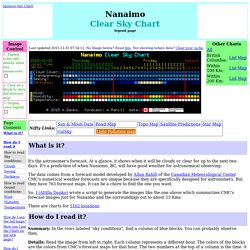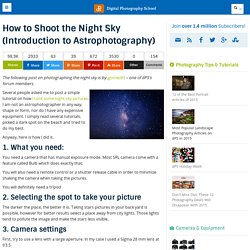

DeepSkyStacker vs Sequator.
Nanaimo Clear Sky Chart. It's the astronomer's forecast.

At a glance, it shows when it will be cloudy or clear for up to the next two days. It's a prediction of when Nanaimo, BC, will have good weather for astronomical observing. The data comes from a forecast model developed by Allan Rahill of the Canadian Meteorological Center. CMC's numerical weather forecasts are unique because they are specifically designed for astronomers. But they have 763 forecast maps. So, I (Attilla Danko) wrote a script to generate the images like the one above which summarizes CMC's forecast images just for Nanaimo and the surroundings out to about 15 Kms. There are charts for 5162 locations. Summary: In the rows labeled "sky conditions", find a column of blue blocks. Details: Read the image from left to right. The line, labeled Cloud Cover forecasts total cloud cover. CMC's text page explaining this forecast is here. The line, labeled Transparency, forecasts the transparency of the air.
This forecasts ground-level relative humidity. Light Pollution Atlas 2006. Northern Lights - forecast. Dark Site Finder – Light Pollution Maps. Space.com: NASA, Space Exploration and Astronomy News. Lonely Speck – How to Photograph the Milky Way – Astrophotography Tutorials, Tools, Gear + Inspiration. Love the Night Sky - Helping you Stargaze Like the Professionals. Dominion Astrophysical Observatory, Astronomy, Observatories, Vancouver Island, BC, Canada. SpaceWeather.com. ?lang=en&coorSystem=WGS84&lon=-124.45&lat=49. Learn Milky Way Photography. Heavens-Above.
SKY-MAP. How to Shoot the Night Sky (Introduction to Astrophotography) The following post on photographing the night sky is by jgomez65 – one of dPS’s forum members.

Several people asked me to post a simple tutorial on how I took some night sky pictures. I am not an astrophotographer in any way, shape or form, nor do I have any expensive equipment. I simply read several tutorials, picked a dark spot on the beach and tried to do my best. Anyway, here is how I did it. 1. You need a camera that has manual exposure mode. You will also need a remote control or a shutter release cable in order to minimize shaking the camera when taking the pictures. You will definitely need a tripod 2. The darker the place, the better it is. 3. First, try to use a lens with a large aperture. Next, set your camera at a high ISO. Finally, in order to avoid the star trail (that is avoiding capturing the movement of the stars as the earth rotates) you have to use the RULE of 600 which is very easy: Divide 600 by the focal length of the lens you are using. 4. 5.
That’s it. Original Image: Astronomy Sky Condition. This web site gives access to up-to-date meteorological forecasts in order to provide astronomers with information to plan their sky observation activities.

The forecasts cover North America and are produced by the numerical weather prediction models that execute at the Canadian Meteorological Center.The following forecast parameters are available in real time: forecasts of cloud, surface winds, temperatures and humidity as well as more specific parameters such as seeing forecasts and sky transparency. Cloud forecastCloud forecasts at hourly intervals up to 48 hours.These forecasts can be interpreted in the same way as satellite pictures in the visible spectrum. Seeing forecastSeeing forecasts at 3-hourly intervals up to 48 hours. The "seeing" is the term used in astronomy to quantify the steadiness or the turbulence of the atmosphere. The detailed observation of planets, planetary nebulae or any celestial object requires excellent seeing conditions.